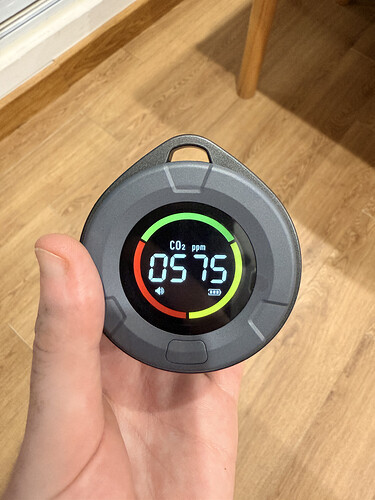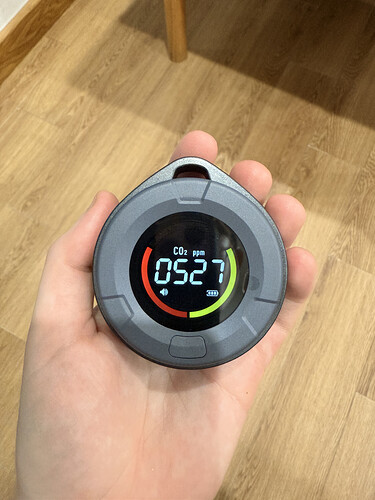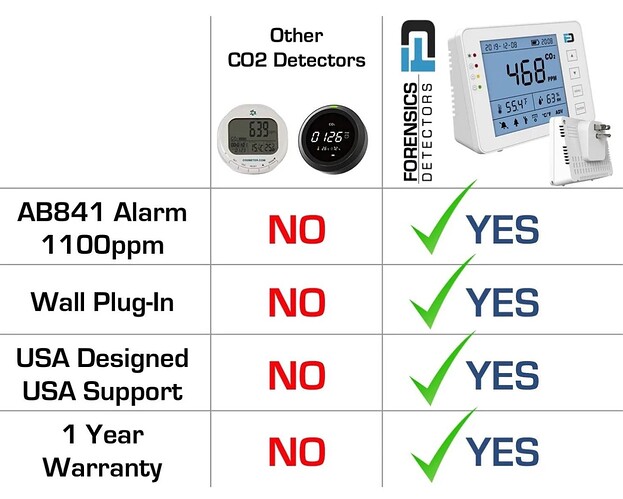For some reason, this forum post outranks my dedicated post on the best CO2 monitors. If you’re interested in learning more about the best carbon dioxide monitors in all price ranges, please refer to the article below. Thank you!
Please note: This post contains affiliate links.
When it comes to carbon dioxide monitors, there is one question I get asked more frequently than any other, and if you’ve read the title of this post, you’ll already know what it is. It is, of course, ‘What are the best affordable carbon dioxide monitors?’. While I’ve already partially answered this question in my article on the best carbon dioxide monitors, I thought discussing the topic in more detail would be great.
Before diving deeper, I want to mention that on my main website, I only discuss monitors with which I have (ample) firsthand experience. This is because I feel uncomfortable recommending any monitor I haven’t tried personally, and I also feel it’s disingenuous. However, there are a few great-looking affordable carbon dioxide monitors out there that I haven’t reviewed yet, and I want to mention them in this post as they are less formal. With that said, if you have experience with any of the monitors in this post, I welcome your thoughts and opinions - in fact, I would love to hear them! Therefore, please feel free to comment below if you have any thoughts. With that said, let’s get started!
Best very low-cost monitor (< $50)
Full review:
It probably surprises no one, but I still recommend the Vitalight Mini CO2 Detector for anyone with a very strict budget. This device is far from perfect but performs well in the most critical metric - accuracy.
The Vitalight Mini CO2 Detector can be found for $30-$50 depending on sales and your location, and the accuracy of this monitor is unmatched at this price. While I have heard some people mention that it doesn’t track well compared to their Aranet4s or other higher-end CO2 monitors, I’ve found the opposite. Across the two Vitalight Mini CO2 Detectors I have, I’ve found that they almost always record very similarly to my Aranet4 Homes and other monitors.
Of course, there are some times when they read very differently, and this is generally due to the (rather frustrating) auto-calibration ‘feature’. This ABC (automatic baseline calibration) operation is performed about every seven days, and it sees the device set a new CO2 baseline at the lowest concentrations it has been exposed to over that period.
This is often advertised as a feature because it means, in theory, that the user doesn’t need to calibrate the monitor. However, this is only the case if the device is regularly exposed to ambient CO2 concentrations, as otherwise, the device’s readings will quickly become skewed. Luckily, the device can be manually calibrated, and as long as it’s managed properly, this device is surprisingly accurate for the price!
Of course, the device does make some compromises at this price point. One of those is that the device lacks connectivity in any form. On top of this, the battery life is very short (around 8 hours), and I’ve heard from some readers that there are quality issues with the device. While I can’t confirm this, as my two devices have worked great (they are now around two years old), it seems to be a relatively common issue. However, I haven’t found any devices as accurate as this one at this price range, so I still think it’s a decent, affordable carbon dioxide monitor.
Other affordable monitors (< $50):
Other options from brands like Temtop are also available in this price range. While I haven’t tried these monitors, they appear to use accurate NDIR or photoacoustic sensors (always check for one of these in any monitor you are considering).
August 2025 update: I now reccomend the INKBIRD PTH-10C as another great and affordable CO2 monitor. Please read the comments on this thread to learn more.
Best affordable carbon dioxide monitor (< $60)
If you don’t mind spending a bit more (typically around $60), you can get a fascinating monitor that performs very well but with a few caveats. I am talking about the Sensirion CO2 Gadget. Now, the biggest downside of this affordable carbon dioxide monitor is that it isn’t an all-in-one device. That is to say, this device needs a battery to operate and it needs to be powered via a USB port. While this might seem a big inconvenience, this monitor has significant advantages over the more affordable Vitalight Mini CO2 Detector.
Firstly, this affordable carbon dioxide monitor uses a Sensirion SCD4x (an SCD40 or SCD41) sensor. This sensor is an ultra-small CO2 sensor which uses photoacoustic technology to provide accurate CO2 concentration measurements. While I do have some minor issues with this sensor (it appears to lose accuracy at higher temperatures), it tends to perform very well at standard temperatures, and it’s also incredibly tiny, meaning it can fit into very compact devices. While I do think this sensor still takes second place to high-quality NDIR sensors such as the SCD30, S8 or Sunrise, it performs well, and I would trust it in most conditions.
Secondly, this monitor supports Bluetooth, meaning you can view data on your smartphone (or PC if you use it on your computer’s USB port). This allows you to see historical data, giving this device a significant advantage over the Vitalight Mini CO2 Detector.
This is a fantastic low-cost solution if you’re looking for a great CO2 monitor for your home or office (or anywhere it can easily be powered). While it can also be used on the go, you will need to sort out a way to power the device. With that said, if you don’t mind also carrying around a battery, this is a fantastic value CO2 monitor.
Best affordable carbon dioxide monitor (< $80)
Full review:
Just a year ago, I would’ve said you needed to spend at least $150 to get a carbon dioxide monitor without major compromises. However, SmartAir and Qingping have since changed the game by making an affordable carbon dioxide monitor with no major downsides. While there are a few quirks to using this monitor, it’s a very well-rounded device, and it can be found for less than half the price of premium devices such as the Aranet4 Home, INKBIRD IAM-T1 and CO2.Click Model C.
The SmartAir CO2 monitor also uses a Sensirion SCD40 photoacoustic sensor and generally has great accuracy except for at very high temperatures (which is an issue that all photoacoustic sensors suffer from). Luckily, in the conditions this monitor will mostly be exposed to, the sensor is accurate and reads similarly to high-end NDIR sensors.
Since Qingping makes the SmartAir/Qingping CO2 monitor, it uses the same app as the Qingping Air Quality Monitor and Air Quality Monitor Lite. Since this app is quite good, I see this as a big advantage of the device, which means you have great connectivity with this monitor. With that said, there is one caveat - while the SmartAir CO2 monitor has Bluetooth and WiFi, it only uses the former to pair with your phone during the initial setup. This means the monitor will not upload data to your phone while on Bluetooth - only once you get home and it’s connected to WiFi again. This isn’t a major issue, as you can still use the device while you’re out, but you won’t be able to view data on your phone until you are home (or somewhere else with WiFi).
However, this is the only big disadvantage of this monitor. The internal battery (which has a 5-30 day battery life) has decent battery life, customisation is good through the app, and accuracy is good. Really, the only other minor gripe I have with this device is that it’s quite large.
For now, that concludes this list of affordable carbon dioxide monitors. Is there anything you would add?








